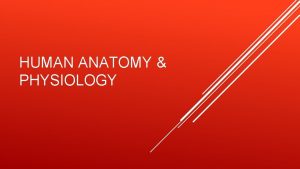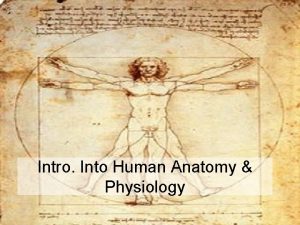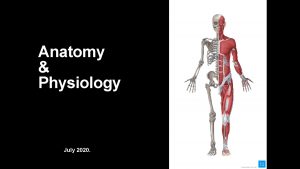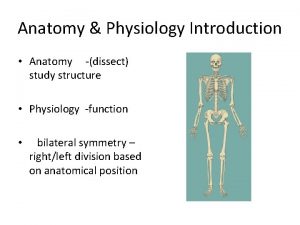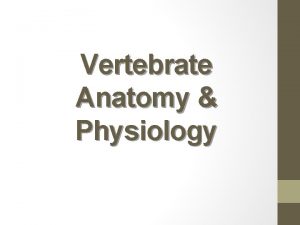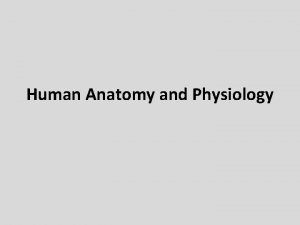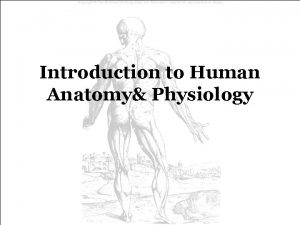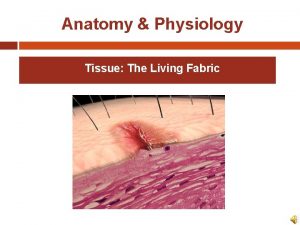Human Anatomy Physiology A Anatomy The study of



















- Slides: 19


Human Anatomy & Physiology

A? Anatomy The study of structure of an organism Dissection is the principle technique used to isolate and study the structural components or parts of the body. Physiology The study of the function of the body (what parts do and how & P?

All living things… Move. � Self initiated change of position, movement of internal parts Respond. � Ability to sense changes within or to surroundings and react to them Grow. � Increase body size Reproduce. � Parents (or individual) create offspring Respire. � Obtain O 2 Digest. � Chemically breakdown food and getting rid of wastes Absorb. � Passage of food products through membranes and into body fluids Circulate. � Movements of substances through body Assimilate. � Changing of absorbed substances into chemically different ones Excrete. � Removal of wastes.

How can you remember all that? • Create a mental map! I am walking to Mcdonalds (movement) I stop at the traffic light (response) My body is growing (growth) I am breathing air (respiration) I get a hamburger and eat it (digestion) My body absorbs the hamburger (absorption) The hamburger circulates in my body (circulation) The hamburger is changed to things my body needs (assimilation) Eventually, I go to the bathroom (excretion) Someday I may reproduce (reproduction)

Cells? • the basic unit of a living that can perform all the processes associated with life. • vary in type and function.

Energy and Metabolism? Energy is the ability to do WORK! Energy can be obtained from the environment. Energy is needed for living things to grow, develop, and reproduce. Energy FLOWS in an ecosystem. It cannot be created nor destroyed, only changed in form. Metabolism �the chemical activities of building up or breaking down materials within an organism.

Stimulus and Response? • Stimulus - any change that occurs in the environment. • Response - a reaction to any change in the environment or “stimulus”.

Reproduction and Adaptation? Reproduction � process by which organisms give rise to offspring. Sexual reproduction � reproduction through the union of male and female gamete Asexual reproduction � reproduction in which a single individual copies its genetic material Adaptations �a character or structure that helps an organism live and reproduce successfully in it’s environment. �are developed through evolutionary processes. �Environmental stresses force adaptation or extripation of species.

Levels of Organization • You need to memorize this!!

Organ Systems

Organs & Organ Systems Organ System - groups of organs working together to perform special functions. Outer Protection Integumentary - protects the body from injury and invasion, serves as a chemical barrier, regulation of temperature, production of hormones, excretion, and sensory detection Support and Movement Skeletal - supports and protects body Muscular - provides support and motion Communication, Control, and Integration Nervous - sends messages throughout body, controls life functions, and responds to environment

• Endocrine - controls various body functions by releasing hormones directly into the blood stream Transportation and Defense • Digestive - breaks down food for energy • Circulatory - transports food and oxygen, removes waste • Respiratory - supplies oxygen and removes carbon dioxide • Excretory - remove waste

Directional Terms p. 13 http: //www. wisc-online. com/objects/View. Object. aspx? ID=AP 15305

Body Cavities

Body Parts & Regions p. 15

Body Parts & Regions p. 16

Subdivisions of the Abdomen p. 16

Planes of Section of the Body p. 17
 Endomysium
Endomysium Chapter 1 introduction to human anatomy and physiology
Chapter 1 introduction to human anatomy and physiology Holes essential of human anatomy and physiology
Holes essential of human anatomy and physiology Medial lateral distal proximal
Medial lateral distal proximal Chapter 2 human reproductive anatomy and physiology
Chapter 2 human reproductive anatomy and physiology Paratubular cyst
Paratubular cyst Anatomy and physiology ninth edition
Anatomy and physiology ninth edition 5 functions of the respiratory system
5 functions of the respiratory system Tattoo anatomy and physiology
Tattoo anatomy and physiology Science olympiad anatomy and physiology
Science olympiad anatomy and physiology Specialized stems examples
Specialized stems examples Anatomy and physiology of bone
Anatomy and physiology of bone Peptic ulcer disease anatomy
Peptic ulcer disease anatomy Cantlie line
Cantlie line Difference between anatomy and physiology
Difference between anatomy and physiology Difference between anatomy and physiology
Difference between anatomy and physiology Blood in anatomy and physiology
Blood in anatomy and physiology The central sulcus divides which two lobes? (figure 14-13)
The central sulcus divides which two lobes? (figure 14-13) Http://anatomy and physiology
Http://anatomy and physiology Appendix anatomy and physiology
Appendix anatomy and physiology






















